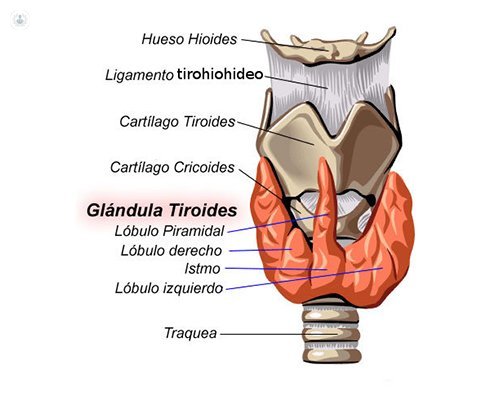Types of thyroid pathologies
Written by:The thyroid gland is located at the front of the neck and weighs between ten and twenty grams. Its function is the production of thyroid hormone, which is essential for growth and metabolism.
Endemic goiter deficit mud is the most common thyroid disease. It affects about 200 million people worldwide. It is characterized by a diffuse enlargement of the gland, which can cause compression symptoms such as dysphagia, dysphonia and dyspnea.
Thyroid goiter prevalence in Spain is between 4 and 7%, the most common thyroid disease.
Thyroid disease is ten times more common in women. Clinical hypothyroidism can affect 2% of women. The most common form of presentation of thyroid disease is the appearance of a solitary nodule, which can be seen in up to 4% of patients between 30 and 50 years.

Types of thyroid pathologies
- Subclinical hypothyroidism is usually asymptomatic. Characteristically the TSH is elevated with normal free T4. In Spain the prevalence rate is 8% and most patients suffered thyroiditis. 50% of cases may end in a clinical hypothyroidism. It does not usually require treatment.
- Hypothyroidism can have multiple clinical manifestations: weakness, tiredness, fatigue, dizziness, irritability, edema, drowsiness, constipation, dry skin, weight gain, hoarseness, anxiety, bradycardia or pleural effusion, among others. Analytically TSH is elevated and low free T4. It is treated with thyroid hormone to standardize analytical figures.
- Hyperthyroidism is also manifested clinically with anorexia variegated form, muscle weakness, weight loss, diarrhea, lethargy, tremor, myopathy, agitation, arrhythmia, confusion or ophthalmopathy. Analytically the TSH is low and elevated free T4. It is treated with beta-blockers and antithyroid. Once it stabilized controlled and treated with sludge 131 and / or surgical intervention.
thyroid neoplasms
Most are diagnosed in adults from a solitary nodule. Between 5 and 12% of solitary nodules and 3% of multinodular goiters may end malignizándose.
The hipocaptantes nodules (cold) are those most likely to become malignant, especially in young patients with a history of cervical or cranial radiation. The high uptake nodules (hot), however, are benign.
The most common malignant nodules are:
- Follicular carcinoma that metastasizes quickly although it has a survival rate of 85% if diagnosed early.
- Papillary carcinoma, which is the most common. It also has a survival rate of 95%.
- Medullary carcinoma, can be diagnosed by detecting early increase calcitonin and protoonogen presence of RET and thus successfully treated.
- Anaplastic carcinoma represents less than 1% of cases. It is the most aggressive.
All require surgical treatment.
To treat a benign solitary nodule the surgeon practice hemithyroidectomy with isthmectomy. If multinodular goiter or neoplasia, total thyroidectomy is necessary. As for cervical neoplasia lymphadenectomy it is necessary.
Some types of neoplasia also benefit and have a better prognosis with postoperative treatment with radioactive sludge.


